Matthew Trager
UCLA-CS
e1: Learning Adaptive Control of Reasoning Effort
Oct 30, 2025Abstract:Increasing the thinking budget of AI models can significantly improve accuracy, but not all questions warrant the same amount of reasoning. Users may prefer to allocate different amounts of reasoning effort depending on how they value output quality versus latency and cost. To leverage this tradeoff effectively, users need fine-grained control over the amount of thinking used for a particular query, but few approaches enable such control. Existing methods require users to specify the absolute number of desired tokens, but this requires knowing the difficulty of the problem beforehand to appropriately set the token budget for a query. To address these issues, we propose Adaptive Effort Control, a self-adaptive reinforcement learning method that trains models to use a user-specified fraction of tokens relative to the current average chain-of-thought length for each query. This approach eliminates dataset- and phase-specific tuning while producing better cost-accuracy tradeoff curves compared to standard methods. Users can dynamically adjust the cost-accuracy trade-off through a continuous effort parameter specified at inference time. We observe that the model automatically learns to allocate resources proportionally to the task difficulty and, across model scales ranging from 1.5B to 32B parameters, our approach enables approximately 3x reduction in chain-of-thought length while maintaining or improving performance relative to the base model used for RL training.
Maximally-Informative Retrieval for State Space Model Generation
Jun 13, 2025Abstract:Given a query and dataset, the optimal way of answering the query is to make use all the information available. Modern LLMs exhibit impressive ability to memorize training data, but data not deemed important during training is forgotten, and information outside that training set cannot be made use of. Processing an entire dataset at inference time is infeasible due to the bounded nature of model resources (e.g. context size in transformers or states in state space models), meaning we must resort to external memory. This constraint naturally leads to the following problem: How can we decide based on the present query and model, what among a virtually unbounded set of known data matters for inference? To minimize model uncertainty for a particular query at test-time, we introduce Retrieval In-Context Optimization (RICO), a retrieval method that uses gradients from the LLM itself to learn the optimal mixture of documents for answer generation. Unlike traditional retrieval-augmented generation (RAG), which relies on external heuristics for document retrieval, our approach leverages direct feedback from the model. Theoretically, we show that standard top-$k$ retrieval with model gradients can approximate our optimization procedure, and provide connections to the leave-one-out loss. We demonstrate empirically that by minimizing an unsupervised loss objective in the form of question perplexity, we can achieve comparable retriever metric performance to BM25 with \emph{no finetuning}. Furthermore, when evaluated on quality of the final prediction, our method often outperforms fine-tuned dense retrievers such as E5.
PICASO: Permutation-Invariant Context Composition with State Space Models
Feb 24, 2025

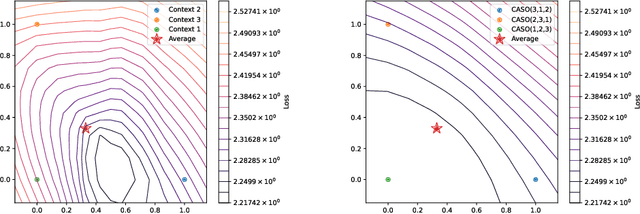

Abstract:Providing Large Language Models with relevant contextual knowledge at inference time has been shown to greatly improve the quality of their generations. This is often achieved by prepending informative passages of text, or 'contexts', retrieved from external knowledge bases to their input. However, processing additional contexts online incurs significant computation costs that scale with their length. State Space Models (SSMs) offer a promising solution by allowing a database of contexts to be mapped onto fixed-dimensional states from which to start the generation. A key challenge arises when attempting to leverage information present across multiple contexts, since there is no straightforward way to condition generation on multiple independent states in existing SSMs. To address this, we leverage a simple mathematical relation derived from SSM dynamics to compose multiple states into one that efficiently approximates the effect of concatenating textual contexts. Since the temporal ordering of contexts can often be uninformative, we enforce permutation-invariance by efficiently averaging states obtained via our composition algorithm across all possible context orderings. We evaluate our resulting method on WikiText and MSMARCO in both zero-shot and fine-tuned settings, and show that we can match the strongest performing baseline while enjoying on average 5.4x speedup.
Descriminative-Generative Custom Tokens for Vision-Language Models
Feb 17, 2025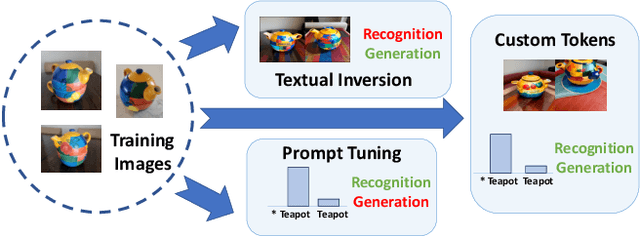

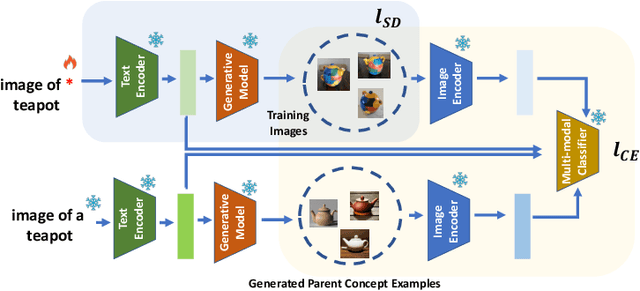

Abstract:This paper explores the possibility of learning custom tokens for representing new concepts in Vision-Language Models (VLMs). Our aim is to learn tokens that can be effective for both discriminative and generative tasks while composing well with words to form new input queries. The targeted concept is specified in terms of a small set of images and a parent concept described using text. We operate on CLIP text features and propose to use a combination of a textual inversion loss and a classification loss to ensure that text features of the learned token are aligned with image features of the concept in the CLIP embedding space. We restrict the learned token to a low-dimensional subspace spanned by tokens for attributes that are appropriate for the given super-class. These modifications improve the quality of compositions of the learned token with natural language for generating new scenes. Further, we show that learned custom tokens can be used to form queries for text-to-image retrieval task, and also have the important benefit that composite queries can be visualized to ensure that the desired concept is faithfully encoded. Based on this, we introduce the method of Generation Aided Image Retrieval, where the query is modified at inference time to better suit the search intent. On the DeepFashion2 dataset, our method improves Mean Reciprocal Retrieval (MRR) over relevant baselines by 7%.
An Invitation to Neuroalgebraic Geometry
Jan 31, 2025



Abstract:In this expository work, we promote the study of function spaces parameterized by machine learning models through the lens of algebraic geometry. To this end, we focus on algebraic models, such as neural networks with polynomial activations, whose associated function spaces are semi-algebraic varieties. We outline a dictionary between algebro-geometric invariants of these varieties, such as dimension, degree, and singularities, and fundamental aspects of machine learning, such as sample complexity, expressivity, training dynamics, and implicit bias. Along the way, we review the literature and discuss ideas beyond the algebraic domain. This work lays the foundations of a research direction bridging algebraic geometry and deep learning, that we refer to as neuroalgebraic geometry.
Geometry and Optimization of Shallow Polynomial Networks
Jan 10, 2025Abstract:We study shallow neural networks with polynomial activations. The function space for these models can be identified with a set of symmetric tensors with bounded rank. We describe general features of these networks, focusing on the relationship between width and optimization. We then consider teacher-student problems, that can be viewed as a problem of low-rank tensor approximation with respect to a non-standard inner product that is induced by the data distribution. In this setting, we introduce a teacher-metric discriminant which encodes the qualitative behavior of the optimization as a function of the training data distribution. Finally, we focus on networks with quadratic activations, presenting an in-depth analysis of the optimization landscape. In particular, we present a variation of the Eckart-Young Theorem characterizing all critical points and their Hessian signatures for teacher-student problems with quadratic networks and Gaussian training data.
The N-Grammys: Accelerating Autoregressive Inference with Learning-Free Batched Speculation
Nov 06, 2024
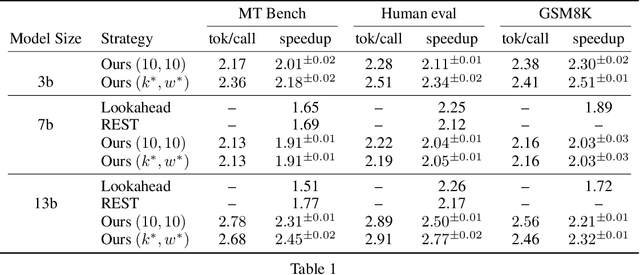


Abstract:Speculative decoding aims to speed up autoregressive generation of a language model by verifying in parallel the tokens generated by a smaller draft model.In this work, we explore the effectiveness of learning-free, negligible-cost draft strategies, namely $N$-grams obtained from the model weights and the context. While the predicted next token of the base model is rarely the top prediction of these simple strategies, we observe that it is often within their top-$k$ predictions for small $k$. Based on this, we show that combinations of simple strategies can achieve significant inference speedups over different tasks. The overall performance is comparable to more complex methods, yet does not require expensive preprocessing or modification of the base model, and allows for seamless `plug-and-play' integration into pipelines.
Compositional Structures in Neural Embedding and Interaction Decompositions
Jul 12, 2024
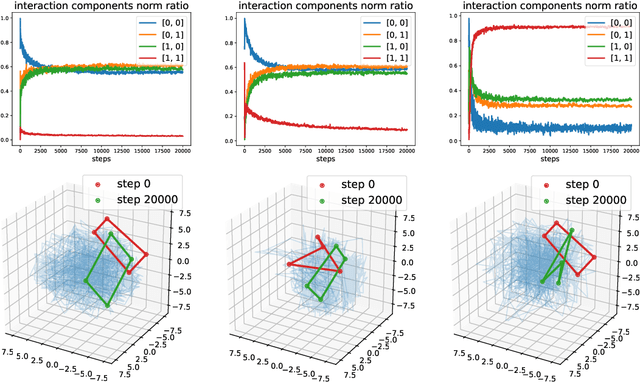
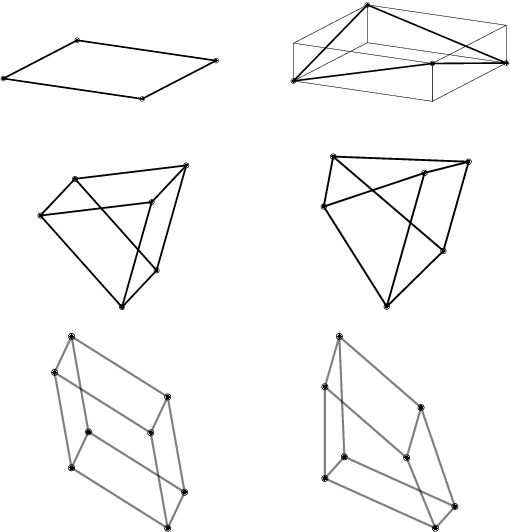
Abstract:We describe a basic correspondence between linear algebraic structures within vector embeddings in artificial neural networks and conditional independence constraints on the probability distributions modeled by these networks. Our framework aims to shed light on the emergence of structural patterns in data representations, a phenomenon widely acknowledged but arguably still lacking a solid formal grounding. Specifically, we introduce a characterization of compositional structures in terms of "interaction decompositions," and we establish necessary and sufficient conditions for the presence of such structures within the representations of a model.
B'MOJO: Hybrid State Space Realizations of Foundation Models with Eidetic and Fading Memory
Jul 08, 2024Abstract:We describe a family of architectures to support transductive inference by allowing memory to grow to a finite but a-priori unknown bound while making efficient use of finite resources for inference. Current architectures use such resources to represent data either eidetically over a finite span ("context" in Transformers), or fading over an infinite span (in State Space Models, or SSMs). Recent hybrid architectures have combined eidetic and fading memory, but with limitations that do not allow the designer or the learning process to seamlessly modulate the two, nor to extend the eidetic memory span. We leverage ideas from Stochastic Realization Theory to develop a class of models called B'MOJO to seamlessly combine eidetic and fading memory within an elementary composable module. The overall architecture can be used to implement models that can access short-term eidetic memory "in-context," permanent structural memory "in-weights," fading memory "in-state," and long-term eidetic memory "in-storage" by natively incorporating retrieval from an asynchronously updated memory. We show that Transformers, existing SSMs such as Mamba, and hybrid architectures such as Jamba are special cases of B'MOJO and describe a basic implementation, to be open sourced, that can be stacked and scaled efficiently in hardware. We test B'MOJO on transductive inference tasks, such as associative recall, where it outperforms existing SSMs and Hybrid models; as a baseline, we test ordinary language modeling where B'MOJO achieves perplexity comparable to similarly-sized Transformers and SSMs up to 1.4B parameters, while being up to 10% faster to train. Finally, we show that B'MOJO's ability to modulate eidetic and fading memory results in better inference on longer sequences tested up to 32K tokens, four-fold the length of the longest sequences seen during training.
NeRF-Insert: 3D Local Editing with Multimodal Control Signals
Apr 30, 2024



Abstract:We propose NeRF-Insert, a NeRF editing framework that allows users to make high-quality local edits with a flexible level of control. Unlike previous work that relied on image-to-image models, we cast scene editing as an in-painting problem, which encourages the global structure of the scene to be preserved. Moreover, while most existing methods use only textual prompts to condition edits, our framework accepts a combination of inputs of different modalities as reference. More precisely, a user may provide a combination of textual and visual inputs including images, CAD models, and binary image masks for specifying a 3D region. We use generic image generation models to in-paint the scene from multiple viewpoints, and lift the local edits to a 3D-consistent NeRF edit. Compared to previous methods, our results show better visual quality and also maintain stronger consistency with the original NeRF.
 Add to Chrome
Add to Chrome Add to Firefox
Add to Firefox Add to Edge
Add to Edge